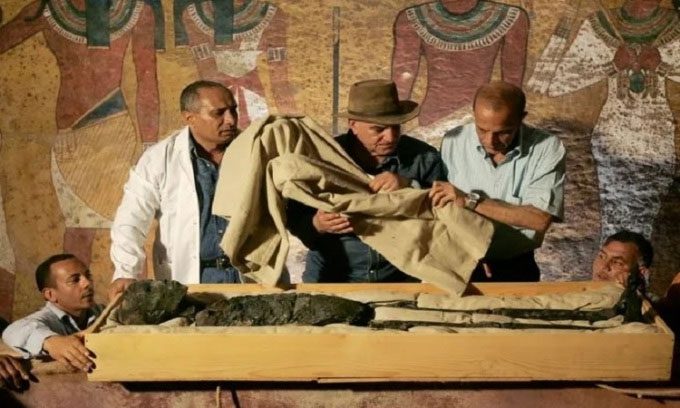Egyptologists speculate that King Tutankhamun was relatively thin, walked with a limp, had a slightly elongated skull, and protruding teeth based on his mummy, paintings, and statues.
One hundred years ago, on November 4, 1922, a group of archaeologists discovered the tomb of Pharaoh Tutankhamun, revealing many secrets about ancient Egypt, including the mummy of the young king. This discovery provided a wealth of information about Tutankhamun, who ascended to the throne at the age of 9 and died at 19. However, researchers still do not know exactly what this king looked like. Studies primarily examine the health of King Tutankhamun, and several projects have attempted to digitally reconstruct his portrait, as reported by Live Science on November 2.

Zahi Hawass (center) transferring the mummy of King Tutankhamun from the sarcophagus. (Photo: Sarasota Herald Tribune)
A study on Tutankhamun and other mummies published in 2010 in the JAMA journal concluded that King Tutankhamun was approximately 1.67 meters tall at the time of his death and suffered from several ailments such as malaria and Köhler disease, which caused swelling in his feet and hindered his mobility. He also experienced necrosis (tissue death) due to a fracture in his left foot, contributing to his death.
“Tutankhamun looked like a sickly person,” said Zahi Hawass, former Minister of Antiquities of Egypt and co-author of the study in JAMA. “He walked with a limp and had to use a cane.”
Despite his health issues, Tutankhamun remained quite active. “The king enjoyed hunting wild animals and built a palace near the Sphinx to go hunting,” Hawass shared. “Despite any physical problems, he was active enough to have an accident and injure his leg just two days before his death.”
Hutan Ashrafian, a clinical lecturer in anatomy at the Royal College of London, noted that King Tutankhamun walked with a limp, had a slightly elongated skull, and a large chest (due to gynecomastia caused by hormonal imbalance), protruding teeth, and was relatively thin. His appearance seemed quite frail.
In 2012, Ashrafian published a study in the journal Epilepsy & Behavior indicating that Tutankhamun and his ancestors suffered from epilepsy leading to seizures. According to Ashrafian, some of the king’s health issues may be related to genetic diseases due to inbreeding, as Pharaohs of the 18th dynasty often married relatives.
Scholars have been cautious regarding several attempts to reconstruct the face of King Tutankhamun over the years. “The reconstruction results still have many uncertainties such as wrinkles, eye color, hair color, skin tone, and small scars,” said Dr. Frank Rühli, head of the medical department at the University of Zurich. Rühli has studied Egyptian mummies, including King Tutankhamun’s, and noted that on average, mummy tissue shrinks by 53% compared to when it was alive. The mummy of King Tutankhamun has also undergone significant changes compared to his living form. For example, in ancient times, mummies often caught fire from embalming oils, making the reconstruction of the Pharaoh’s face extremely challenging. Additionally, CT scan results cannot accurately reflect the shape of soft tissue prior to death.





















































